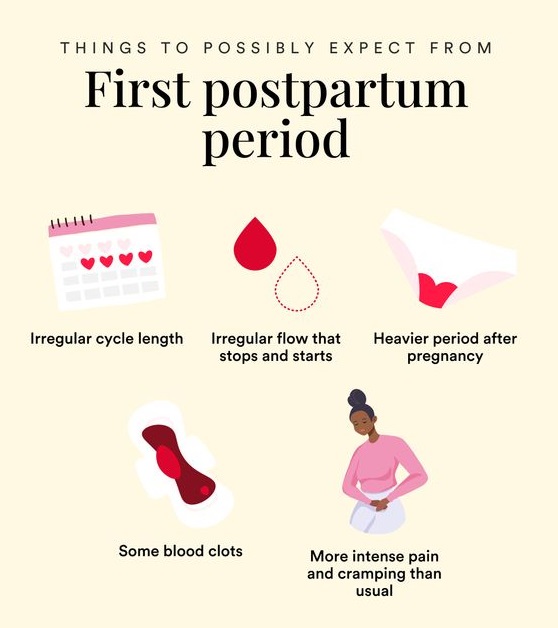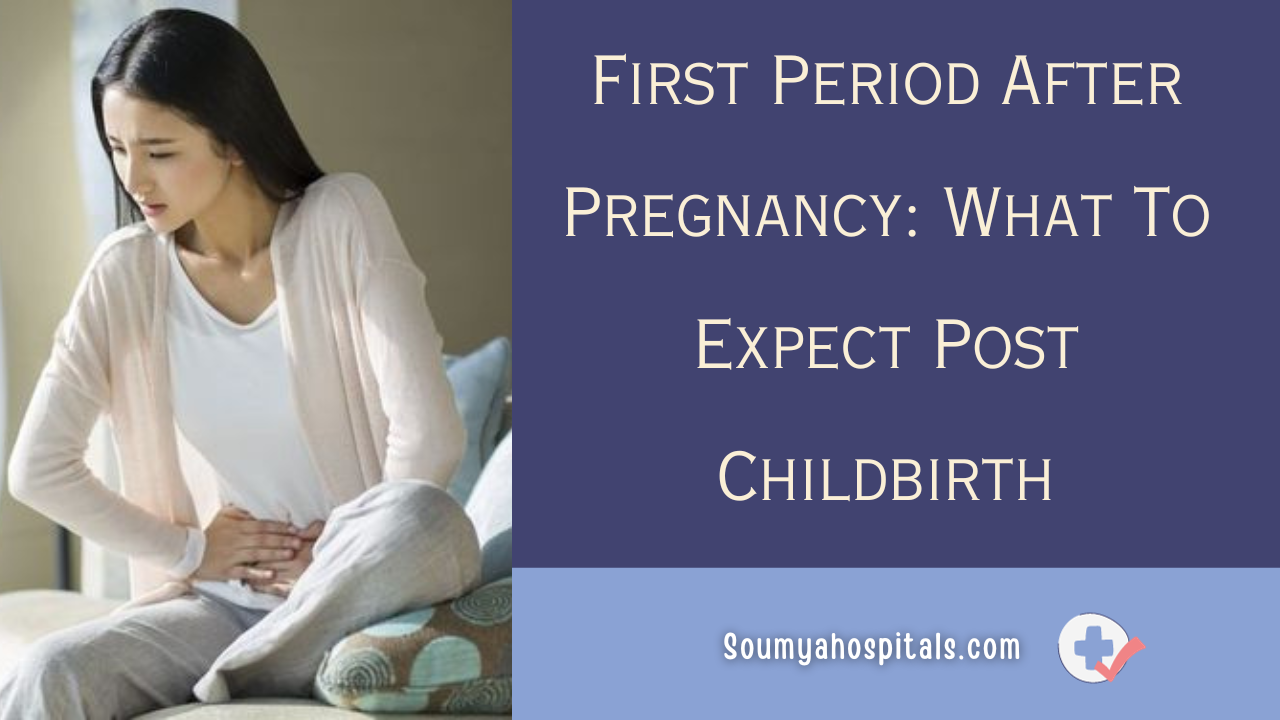As the roller coaster you hopped on at the start of pregnancy finally slows down postpartum, you remember a familiar but demanding friend who’s been missing in action for a while now. The Period. It is about time she returned, you reckon. But when exactly can you expect to see your period back and how does it affect your post-birth rhythm?
While it may not be possible to anticipate the exact date you’ll need those pads or tampons again, there is definitely a single factor which influences that date – prolactin, the hormone that enlarges your mammary glands during pregnancy and stimulates milk production after childbirth. Prolactin also hampers the production of estrogen and progesterone, the fertility hormones. This suppresses ovulation and the menstrual cycle after childbirth. The more your baby suckles at your breast, the greater the amount and frequency of prolactin release by the pituitary gland. So, essentially, your prolactin level determines when you get your first period after pregnancy.
Expect Your Periods 6–8 Months After Delivery If You Are Breastfeeding
If your baby is completely dependent on your breastmilk for its nutritional needs, you may not have your periods for 6–8 months or until you introduce the bottle or solid foods. This gap varies greatly based on genetic factors, how frequently and how long you feed your baby, and your unique hormonal profile. So there are several instances of breastfeeding women who go without a period for 1 year or more after childbirth.
Expect It 1 Month After Childbirth When The Baby Is Bottle-Fed
If you have been bottle-feeding your baby completely, or even partially, studies show that you may not get a period till your baby is a month old. After that, be prepared for the surprise visitor anytime. When the baby is not breastfed, the prolactin levels of the mother return to pre-pregnancy levels within 2–3 weeks of childbirth. So you could get back into the flow as early as 5–6 weeks after childbirth.

Bleeding Or Spotting For A Few Days After Delivery Is Not Period
In the first few weeks after delivery, you may notice some bleeding. This is lochia, a normal discharge that contains blood, mucus, and uterine tissue. This should not be confused with your usual period. Usually, fresh red blood gradually changes to pinkish spotting after the first 4 days after childbirth. For some women, it is normal for spotting to continue up to 6 weeks. But do consult your gynecologist if you notice any greenish color or unusual odor in the lochia – these may be signs of an infection.
Do remember that lochial discharge and period cannot take place simultaneously because for the menstrual cycle to resume, the uterus must go back to its pre-pregnancy stage. If you are not breastfeeding, the gap between the end of your lochia and the beginning of your first period after pregnancy could be anywhere from a couple of days to a week. If you are breastfeeding, it could be several months.
Postpartum Periods May Be Erratic Initially And Slightly Different
Pregnancy and the arrival of your baby transformed your body and your life. You can expect the first period after childbirth to be a little different from “the normal” too.
In many women, the period makes its appearance gently, in the form of light spotting. The spotting may begin any time after the baby starts feeding less frequently. If you are lucky, menstrual cramps may reduce or disappear due to the widening of the cervix after delivery.
Other women may experience heavy bleeding and intense cramps during the first postpartum period. Passing a few blood clots as part of the menstrual bleeding is also normal. If the bleeding is so heavy that you have to change your pad or tampon every hour or so, or the clots continue to appear for more than a week, you must consult the doctor to rule out infections, fibroids, or other complications. It may take a few months for your menstrual cycle to become regular again.
Boost Postpartum Menstrual Health With Natural Remedies And Diet
While you may not be able to predict or significantly control the genetic and hormonal factors that influence your menstrual cycle after childbirth, you can certainly focus on your physical and mental well-being. As you know, a complex combination of physical, dietary, and emotional factors affect the process associated with ovulation at all ages – and especially in the postpartum period. This is also the time to finally take a breather and enjoy some well-deserved and much-needed TLC whenever you can – consider it a long-term health and happiness insurance!
Traditional systems of medicine across cultures prescribe special care for the new mother in the first 3 months after delivery. This is the period when the uterus begins to shrink back to its original size and the uterine muscles begin to recover from the strain of pregnancy and childbirth. This is also the time when post-pregnancy hormones and numerous other factors induce postpartum depression in at least 15 percent of new mothers.

Postpartum care also includes appropriate nutrition. The ideal postpartum diet is not only easy to digest but also provides the body with the nutrients that are most essential at this stage, including protein, iron, and calcium. It also includes foods that can cleanse the uterus, promote the production of milk (galactagogues), and increase blood supply. The Chinese confinement diet, for instance, includes dark green leafy vegetables such as curly kale and beans such as adzuki that are believed to boost blood and Qi levels. In India, certain vegetables and herbs have been traditionally considered staples in the postpartum diet and medication regimen.
Here are some tips from traditional postnatal care practices and dietary guidelines to help your body and mind be better prepared for the return of the period.
Eat Moringa To Boost Blood Iron Levels

Leaves of the drumstick tree (Moringa oleifera) are considered a superfood during pregnancy and breastfeeding. Lactating mothers are regularly served a simple stir-fry of the leaves with turmeric and garlic, which have antiseptic and anti-inflammatory properties. Moringa leaves can boost milk production, but ayurvedic practitioners also recommend these leaves for menstruating women because of their high iron content. Moringa is now widely available in herbal medicine stores in capsule and dried powder forms.
Have Garden Cress To Regulate Periods
In certain parts of India, sweet treats such as kheer and ladoos made of garden cress or halim seeds (Lepidium sativum) are the desserts of choice for postpartum women. These high-protein, low-fat seeds are rich in iron and contain estrogen-like phytochemicals that can help regulate the menstrual cycle.
Take Shatavari To Cleanse The Uterus
The Sanskrit name of Asparagus racemosus literally means “curer of a hundred diseases.” The root has legendary properties as a galactagogue because of its ability to stimulate prolactin production. But it is equally potent in helping the uterus get back to its normal condition after delivery, cleansing the uterus and regulating postpartum bleeding. Shatavari also has a calming effect and is often prescribed to alleviate postpartum depression. An ayurvedic practitioner can give you specific advice on how to use this herb.
Heal The Uterus With Heat

Some Western cultures call it “mother roasting.” In parts of Southeast Asia, it is known as “fire rest.” A common thread that runs across the post-natal care regimen of women in communities as diverse as the Cherokee Indians, Australian aboriginals, Thais, Chinese, and Indians is the practice of infusing deep heat to enable the body to heal. This therapeutic use of heat has several benefits – it can reduce uterine cramps, expel excess fluids, cleanse the uterus, and promote a sense of calmness.
In ayurveda, medicated oil is applied on the body and then washed away with vethuvellam, bath water prepared by boiling leaves and barks of trees such as mango, jackfruit, and banyan. A qualified ayurvedic practitioner can guide you on the use of these medicinal preparations.
Caution: You Could Get Pregnant Even Before Your Periods Resume
Many new moms assume they won’t get pregnant if their period hasn’t yet made an appearance. But while rare, know that it is a possibility. Your body typically releases an egg about 2 weeks before you get your period. This means that you could actually be fertile again some time in the postpartum period even before your period officially announces your fertility.
While breastfeeding is used by many new mothers as a cheap and convenient way of contraception, note that it does not offer protection against sexually transmitted diseases. Besides, the reliability of this method is highly conditional.
While lactational amenorrhea or the absence of periods while breastfeeding has about 98 percent reliability as a method of contraception in the first 6 months after you give birth, 3 conditions are essential for the success of this method:

- Your baby is less than 6 months old.
- You have not yet got your first period after childbirth.
- Your baby is exclusively breastfed.19 20 Talk to your doctor to find out what method of contraception is best for you.
Read More:
